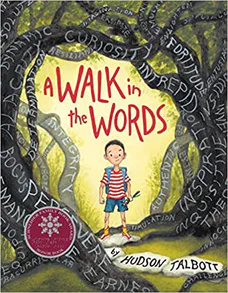A Walk in the Words

Recommended Age Range: 1st grade through 4th grade.
Publisher's Summary:
When Hudson Talbott was a little boy, he loved drawing, and it came naturally to him. But reading? No way! One at a time, words weren’t a problem, but long sentences were a struggle. As his friends moved on to thicker books, he kept his slow reading a secret. But that got harder every year. He felt alone, lost, and afraid in a world of too many words. Fortunately, his love of stories wouldn’t let him give up. He started giving himself permission to read at his own pace, using the words he knew as stepping-stones to help draw him into a story. And he found he wasn’t so alone–in fact, lots of brilliant people were slow readers, too. Learning to accept the fact that everyone does things in their own unique way, and that was okay, freed him up and ultimately helped Hudson thrive and become the fabulous storyteller he is today.

Dr. Annie's Takeaways
Recommended for: This book, written by an author with his own history of reading challenges, reframes reading slowly as “savor[ing] the story” and shares the author’s own journey from feeling ashamed of his reading speed, to feeling overwhelmed when books lost their pictures, to “enjoy[ing] the ride” once he became more comfortable reading at his own pace. This would be a great read for children who are feeling self-conscious or ashamed about reading more slowly than their peers and who need a reminder that reading quickly is not the point of reading.
Tone: Emotionally resonant, validating, hopeful
Story Quality: This story is based on the author’s childhood difficulties with reading and how he made peace with words and the speed with which he reads. The book uses metaphors to convey different feelings (e.g., a wall to show the shame he feels trying to hide his reading challenges, a dense forest of words to show his overwhelm when reading a page with a lot of text, flying books chasing him). It mostly works well and helps to convey the intensity of feelings that many kids with reading challenges feel. Because the book is based on the author’s real experience, which he explains in the author’s note at the end of the story, it has a real authenticity to it, and it provides hope without invalidating the difficulties.
Illustrations: Complex, detailed illustrations that feature books and words as characters and settings.
Representation: The main character is a White boy who is based on the author as a child. He loves to draw and likes words “one at a time,” but he reads slower than the other kids in his class, and he is intimidated by books with lots of text and no pictures. The boy shares that he pictures each word he reads individually, and his mind wanders off when he reads a long sentence. The boy does not have a specific diagnosis. As a part of his journey to make peace with his reading speed, the boy shares about his “Slow Readers Hall of Fame” which includes important people in history who were also reportedly slow readers (e.g., William Shakespeare, Sojourner Truth, Picasso). An effort was made to include in this Hall of Fame men and women of different racial and cultural backgrounds.
Psychological Practices: This book’s primary message is that it is totally okay to read slowly– “Slow readers savor the story!” The main character shares about the shame he initially felt when he realized that he read more slowly than his friends, and about his feeling of overwhelm when he saw a lot of words on a page. He then shares about how he tackled this feeling of overwhelm by focusing on the words he did know and by letting his curiosity guide him. Once he starts to read at his own pace, he starts to enjoy learning new words to use in his stories– “I was learning to paint with words.”
Concerns: None
